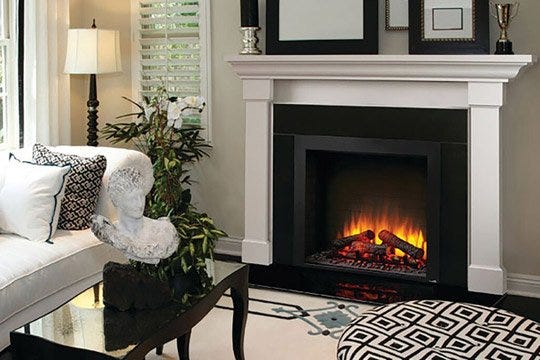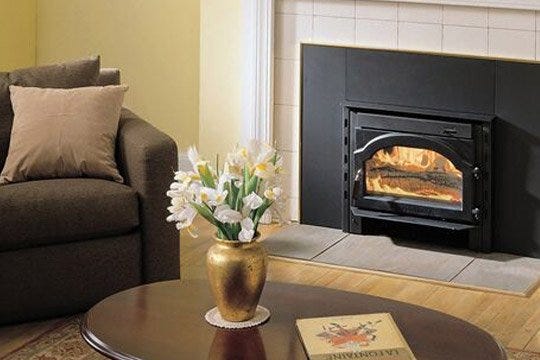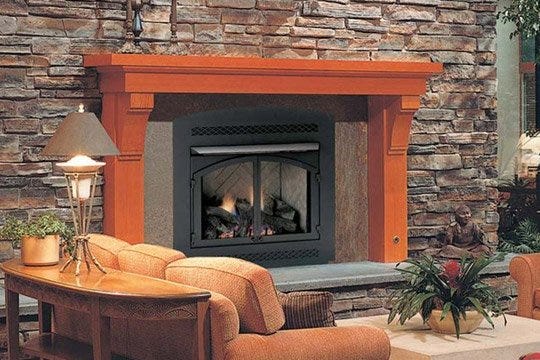Select Your Store
Choose your local Watson's to see the products available in your area.
513-326-1100
Store Hours
Mon-Fri: 10am - 8pm



Choose your local Watson's to see the products available in your area.
Although adding a traditional fireplace to an existing home sounds daunting, gas log systems have been developed to quickly add fireplaces to any home. Read on to learn more about the benefits of vented and vent-free gas log fireplaces.
When installing a gas log set, you'll need to choose between a vented and a vent-free model. Each has its own advantages.
When it comes to a vented gas log set, you can enjoy a large and realistic-looking flame made from an open chimney flue or damper from the burner. Vented gas log sets are created to simulate a wood-burning fireplace and are much more decorative than they are at heating your living space. Most of the heat expelled by a vented set exits your home through the chimney or flue.
Ventless gas logs operate with a closed chimney flue. A vent-free set won’t give you the classic crackling fire effect that you get with gas fireplace logs with a venting system. The flame produced by a ventless unit might not look as realistic or tall compared to vented options. However, vent-free logs are incredibly efficient, as nearly all of the heat that is generated from a ventless fireplace remains in your home. You may also see ventless gas log sets with thermostat controls that help regulate a consistent temperature in your living room. Ventless fireplaces add moisture to the air, so make sure you install proper ventilation in your room to avoid mildew.
Ventless gas logs primarily come in two different styles, ceramic logs and concrete refractory logs. Both log types have their own advantages. Ceramic fiber log sets are known for producing a more realistic fire, the concrete refractory logs tend to hold up better over time.
Fireplace systems with ventless gas logs are typically not permitted in bathrooms, bedrooms, and other home locations because of health and safety. They need to be installed in areas where curtains, clothing, furniture, or flammable objects are at least 3 feet away from the perimeter of the heater. Ventless gas log fireplaces are typically not installed in windy, high-traffic areas. Heavy drafts can be dangerous for homes that use ventless gas log fireplaces.
Gas log sets typically use either natural gas or liquid propane. The choice comes down to several factors.
Natural gas is typically cheaper and burns cleaner. It's ideal if there's already a gas line in your area. It is a lighter gas than air, dissipates when it is released, and does not burn as hot as liquid propane or other gases. However, the benefit of natural gas is that it costs much less. Natural gas logs have to be installed into a pipe system from buried gas service lines.
Propane, on the other hand, is more portable and versatile. If you don't have a natural gas line, propane is a convenient option. Liquid propane has more carbon than natural gas, and it also burns much hotter than natural gas. To get liquid propane logs heating your home, you need a tank to be positioned outside the home. If you decide to purchase a liquid propane gas log fireplace, a tank may be installed outside your home.
Regardless of the fuel type you choose, it's essential to remember to order your set customized to the fuel type your home uses. Several customization options are available to cater to any need.
Starting and controlling your gas log set doesn't have to be a hassle. There are four common systems of control: Remote Controls, Electronic Ignition Models, Manual Safety Pilots, and Match Lights.
Remote controls allow you to operate your fireplace from across the room. Some advanced models even allow you to control the flame height and temperature. Installing a remote control system requires a professional, so keep this in mind when factoring in customization options.
To start electronic ignition models, begin by locating the control panel or remote control. Turn the knob or press the button designated for ignition to activate the electronic spark. Once the flames are lit, use the control panel or remote to adjust the flame height and temperature settings as desired.
With a manual safety pilot, you simply turn a knob to start or control the fire. Most gas log sets come with a factory-installed manual safety pilot. If your set didn't come with one, a professional can install it as a customization option.
Match light systems are the simplest and most natural type of control. All you need to do is turn on the gas and light the logs with a long match or lighter.
Picking the right-sized logs is equally important. Determining the correct size depends on the size of your fireplace and your heating needs. Make sure you track order measurement details before making a purchase.
For a smaller vented gas log set, consider the 21" Osage Oak Vented Log or Cambridge Oak Vented Log. If you need a larger set, these sets also come in 36" sizes. Just remember, safety should be your top priority, so always ensure that there is enough clearance between the logs and the side of the fireplace.
Each manufacturer provides specific sizing information. Should you need more assistance, Watson's customer service representatives are ready to help you select the perfect set.
Remember, choosing the right gas log set will not only add warmth to your home but also enhance its appearance. So take your time, consider your options carefully, and soon you'll have a beautiful and functional fireplace.
Interested in a wood fire stove or gas or electric fireplace? Browse our full selection of fireplaces.
Gas logs are generally known to be cost-effective in operation. However, the total running cost can vary based on certain factors such as your regional gas prices and how often you use your fireplace. In comparison to wood-burning fireplaces, gas log sets offer better heating efficiency as they convert a higher percentage of the fuel to heat and can be regulated more precisely. This can result in considerable savings when used regularly during the colder months.
While ventless gas logs are designed for improved heating efficiency and safety, they must be used with care. They can typically be run for up to four hours at a time, however, ventilating the room after three hours is highly recommended to maintain good air quality.
Gas logs typically have a long lifespan, provided they're well-maintained. Most gas logs are designed to last for a minimum of 5 years, although some can last up to 10 years or more with proper care.
All Fireplaces, Electric Fireplaces, Gas Fireplaces, Fireplace Glass Doors
If you need some guidance or know exactly what you want, our experts can help you achieve your own
personal
style. Or you can always visit our stores to explore the country's most unique
selection of furniture.


More to choose from; more ways to customize your purchase.


Where exceptional quality meets our low price guarantee.


A lifetime of outstanding customer service and expertise you can rely on.


From design to delivery, we help turn your dream home into reality.




